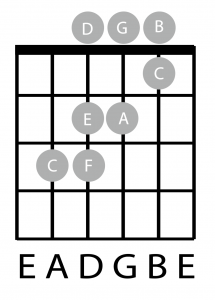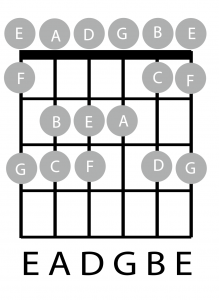We know the C scale has no flats or sharps and we can play it in the first position using D, G and B open strings.
We can play, as shown here: C, D, E, F, G, A, B and C

Also the C scale continues both below and above the two Cs, so we can actually start playing that scale from the open E and above the C on the B string, as far as we want. Let’s go to G (third fret of the E string) so we’re using the C scale notes on the first 3 frets including open strings. A Minor (Am) is the relative minor of C and it doesn’t have any sharps or flats either! You can spell the Am scale just like the C scale just starting on the A! Try it out!
A Minor (Am) is the relative minor of C and it doesn’t have any sharps or flats either! You can spell the Am scale just like the C scale just starting on the A! Try it out!  What this means is, we can play these notes over changes like Am, G, F and Em which would be 1, 7, 6 and 5.
What this means is, we can play these notes over changes like Am, G, F and Em which would be 1, 7, 6 and 5.
Try playing the chord and then the scale from the root note. So, play an Am, then play the scale from the A and so on.
Cool, right? Sounds sort of “Spanish ” to me… and if we want it to sound more like that, we can make one little change and use the harmonic minor scale!More on that to follow. Download this lesson as a pdf file
